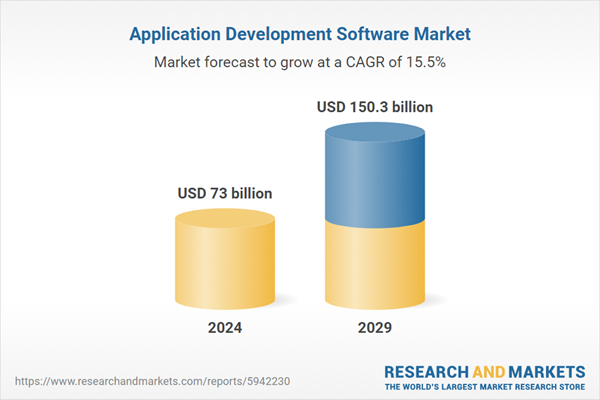Application development software makes valuable business coding applications, such as word processors, enabling a firm to improve its operations by tracking productivity and employee work progress. This software is integral to project planning, customer interaction, and establishing a reliable link with service providers.
The ongoing shift towards digital automation, increased demand for application-specific platforms, and booming cloud computing for processing large company data have greatly boosted the demand for application development software platforms. Moreover, the bolstering growth in work culture in major economies has further laid new norms for workforce skill enhancement and has provided a major scope for overall market growth.
However, technical challenges and issues with scalability, along with high installation costs, can hinder market expansion. This is especially true for local or small-scale firms with limited revenue and technical capabilities, as they lack the necessary infrastructure to operate on such platforms.
Application Development Software Market Drivers:
- Growing cloud software spending has provided new growth prospects for the market.
According to the March 2023 “Cloud Software Spending Survey” issued by Battery Ventures, nearly 58% of the 100 CXOs who participated in the survey have invested more than US$100 million in application software and cloud infrastructure. Compared to 2022, 46% of the technology budget grew in 2023.
Application Development Software Market Geographical Outlook
- North America is poised for significant growth.
According to the “Industrial Software Market Update” provided by Houlihan Lokey, in September 2023, the LTM (Last Twelve Months) financing activity in industrial software reached US$4.2 billion in the United States. Moreover, the growing business strength, followed by the well-established presence of major market players, provides customized offerings to meet customer requirements. These companies are namely Microsoft Corporation, IBM, Google, and Oracle, and are also acting as an additional driving factor for the regional market growth.
Likewise, Europe and Asia Pacific are projected to grow steadily, fueled by the booming digitization and investment in cloud infrastructure. The South American and MEA regions are poised for positive growth.
Reasons for buying this report::
- Insightful Analysis: Gain detailed market insights covering major as well as emerging geographical regions, focusing on customer segments, government policies and socio-economic factors, consumer preferences, industry verticals, other sub- segments.
- Competitive Landscape: Understand the strategic maneuvers employed by key players globally to understand possible market penetration with the correct strategy.
- Market Drivers & Future Trends: Explore the dynamic factors and pivotal market trends and how they will shape up future market developments.
- Actionable Recommendations: Utilize the insights to exercise strategic decision to uncover new business streams and revenues in a dynamic environment.
- Caters to a Wide Audience: Beneficial and cost-effective for startups, research institutions, consultants, SMEs, and large enterprises.
What do businesses use our reports for?
Industry and Market Insights, Opportunity Assessment, Product Demand Forecasting, Market Entry Strategy, Geographical Expansion, Capital Investment Decisions, Regulatory Framework & Implications, New Product Development, Competitive IntelligenceReport Coverage:
- Historical data & forecasts from 2022 to 2029
- Growth Opportunities, Challenges, Supply Chain Outlook, Regulatory Framework, Customer Behaviour, and Trend Analysis
- Competitive Positioning, Strategies, and Market Share Analysis
- Revenue Growth and Forecast Assessment of segments and regions including countries
- Company Profiling (Strategies, Products, Financial Information, and Key Developments among others)
The Application Development Software market is segmented and analyzed as follows:
- By Platform
- No Code Development Platform
- Low Code Development Platform
- By Deployment
- Cloud
- On-Premise
- By Enterprise Size
- Small and Medium Enterprises (SMEs)
- Large Enterprise
- By Application Type
- Mobile Application Development
- Desktop Application Development
- Web and Cloud Application Development
- By End-User
- IT & Telecommunication
- BFSI
- Media and Entertainment
- Government
- Education
- Others
- By Geography
- North America
- United States
- Canada
- Mexico
- South America
- Brazil
- Argentina
- Others
- Europe
- UK
- Germany
- France
- Italy
- Others
- Middle East and Africa
- Saudi Arabia
- Israel
- Others
- Asia Pacific
- Japan
- China
- India
- South Korea
- Indonesia
- Thailand
- Others
- North America
Table of Contents
Companies Mentioned
Some of the key companies profiled in this Application Development Software Market report include:- Microsoft
- Oracle
- IBM
- Twilio Inc.
- Datadog
- Fujitsu
- SAP SE
- HCL Technologies Limited
- Zoho Corporation Pvt. Ltd.
- GitHub, Inc.
Table Information
| Report Attribute | Details |
|---|---|
| No. of Pages | 143 |
| Published | September 2024 |
| Forecast Period | 2024 - 2029 |
| Estimated Market Value ( USD | $ 73 billion |
| Forecasted Market Value ( USD | $ 150.3 billion |
| Compound Annual Growth Rate | 15.5% |
| Regions Covered | Global |
| No. of Companies Mentioned | 12 |








